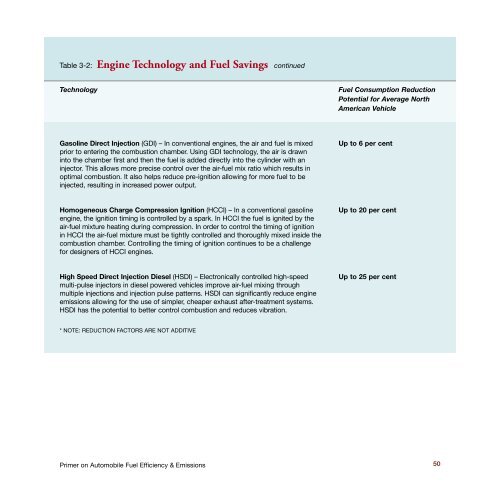Primer on Automobile Fuel Efficiency and Emissions - Pollution Probe
Primer on Automobile Fuel Efficiency and Emissions - Pollution Probe
Primer on Automobile Fuel Efficiency and Emissions - Pollution Probe
You also want an ePaper? Increase the reach of your titles
YUMPU automatically turns print PDFs into web optimized ePapers that Google loves.
Table 3-2: Engine Technology <strong>and</strong> <strong>Fuel</strong> Savings c<strong>on</strong>tinued<br />
Technology<br />
<strong>Fuel</strong> C<strong>on</strong>sumpti<strong>on</strong> Reducti<strong>on</strong><br />
Potential for Average North<br />
American Vehicle<br />
Gasoline Direct Injecti<strong>on</strong> (GDI) – In c<strong>on</strong>venti<strong>on</strong>al engines, the air <strong>and</strong> fuel is mixed<br />
prior to entering the combusti<strong>on</strong> chamber. Using GDI technology, the air is drawn<br />
into the chamber first <strong>and</strong> then the fuel is added directly into the cylinder with an<br />
injector. This allows more precise c<strong>on</strong>trol over the air-fuel mix ratio which results in<br />
optimal combusti<strong>on</strong>. It also helps reduce pre-igniti<strong>on</strong> allowing for more fuel to be<br />
injected, resulting in increased power output.<br />
Up to 6 per cent<br />
Homogeneous Charge Compressi<strong>on</strong> Igniti<strong>on</strong> (HCCI) – In a c<strong>on</strong>venti<strong>on</strong>al gasoline<br />
engine, the igniti<strong>on</strong> timing is c<strong>on</strong>trolled by a spark. In HCCI the fuel is ignited by the<br />
air-fuel mixture heating during compressi<strong>on</strong>. In order to c<strong>on</strong>trol the timing of igniti<strong>on</strong><br />
in HCCI the air-fuel mixture must be tightly c<strong>on</strong>trolled <strong>and</strong> thoroughly mixed inside the<br />
combusti<strong>on</strong> chamber. C<strong>on</strong>trolling the timing of igniti<strong>on</strong> c<strong>on</strong>tinues to be a challenge<br />
for designers of HCCI engines.<br />
Up to 20 per cent<br />
High Speed Direct Injecti<strong>on</strong> Diesel (HSDI) – Electr<strong>on</strong>ically c<strong>on</strong>trolled high-speed<br />
multi-pulse injectors in diesel powered vehicles improve air-fuel mixing through<br />
multiple injecti<strong>on</strong>s <strong>and</strong> injecti<strong>on</strong> pulse patterns. HSDI can significantly reduce engine<br />
emissi<strong>on</strong>s allowing for the use of simpler, cheaper exhaust after-treatment systems.<br />
HSDI has the potential to better c<strong>on</strong>trol combusti<strong>on</strong> <strong>and</strong> reduces vibrati<strong>on</strong>.<br />
Up to 25 per cent<br />
* NOTE: REDUCTION FACTORS ARE NOT ADDITIVE<br />
<str<strong>on</strong>g>Primer</str<strong>on</strong>g> <strong>on</strong> <strong>Automobile</strong> <strong>Fuel</strong> <strong>Efficiency</strong> & Emissi<strong>on</strong>s<br />
50
















